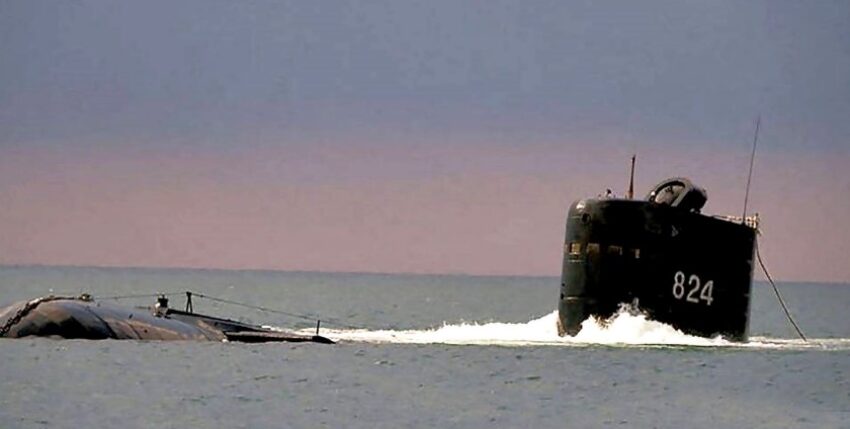North Korean ruler Kim Jong-un is organising his armed forces ever more strategically. North Korea's navy is gearing up for an asymmetric war.
At the end of the 16th century, Korea under Admiral Yi Sun-Sin deployed manoeuvrable, heavily armed ships that were also "armoured" with a bronze shield to successfully fend off various offensives by the much larger Japanese fleet. Due to their resilience, these units were known as "turtle ships". In the 21st century, North Korea is now also relying on an asymmetric fleet to offset the superiority of the much stronger fleets of South Korea, Japan and the USA.
Pyongyang maintains much greater secrecy with regard to its armed forces than Russia or China. Western intelligence is therefore largely based on intelligence analysis, commercial satellite imagery and estimates. As the land forces form the backbone of the armed forces, the original mission of the North Korean navy is to support them. Accordingly, its appearance in the armed forces structure is not very prominent. Internationally known as the Korean People's Navy (KPN for short), the naval units of the navy of the Democratic People's Republic of Korea are therefore primarily designed for operations in the Korean territorial sea and in waters close to the coast. Over the last 20 years, this mission has been slowly but steadily expanded to include the concept of regional power projection. For practical reasons, North Korea is unlikely to develop an ocean-going fleet, but the submarine component is being systematically supplemented by units that are primarily intended to provide new options for countering - and thus also deterring - US forces.
Fleet structure
Two naval commands, 16 squadrons, two special forces brigades and coastal defence units are under the command of the naval headquarters in Pyongyang. The two naval commands are focussed on operations in the Yellow Sea (Western Fleet) and the Sea of Japan (Eastern Fleet) respectively. Both the limited range of most units and the fact that North Korean ships would have to pass through the Tsushima Strait, which is controlled by South Korea and Japan, prevent the regular exchange of units between the two fleets. For the same reason, mutual tactical support in the event of war is virtually impossible. The fleet has an estimated 800 to 1,000 mostly small units from Soviet-Russian, Chinese and domestic production, most of which are considered obsolete. However, there is currently targeted investment in speedboats and submarines, which are intended to offer asymmetric combat value against modern and well-armed opponents. The size of the CPN is around 60,000 soldiers, including a large number of conscripts who will have to serve in the fleet for five to ten years.
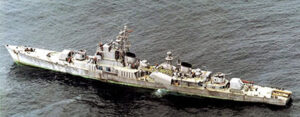
The largest units in the fleet are the two NAJIN-class frigates (102 m, 1500 t, similar to the Soviet KOLA class) built in the 1970s, which were modernised ten years ago by fitting 2x2 KN-09 (Russian Kh-35 uranium) anti-ship missiles.
In addition, there are two light frigates of the TUMAN class (76 m, 1300 tonnes), which were launched around ten years ago. They are equipped with Kh-35 anti-ship missiles, anti-submarine missiles and torpedoes. Reconnaissance photos show these light frigates both with and without a helicopter deck.
The core of the fleet consists of countless very old gunboats and speedboats with a displacement of less than 200 tonnes. Depending on the class of boat, their armament consists of heavy machine guns, light to medium guns, multiple rocket launchers and torpedo tubes mounted on the upper deck. Their main missions are swarm attacks on enemy warships, fire support for ground troops in coastal areas and firing on enemy coastal installations.
The newer small combat units include the 200-tonne, 35 to 40 metre long SES catamaran fast patrol boats of the NONGO class. They were built in two versions, including a variant with a reduced radar signature thanks to angled hull superstructures. Depending on the variant, the boats, which can reach speeds of up to 48 knots, carry four or eight Kh-35 anti-ship missiles and artillery guns with a calibre of 30 and 14.5 millimetres. The NONGO class was introduced around the turn of the millennium and was retrofitted in the middle of the last decade; there are probably only six units in service.
Finally, the KPN has a limited number of very fast small combat boats. The five versions have lengths of between 10 and 34 metres. The smaller boats are intended to drop special commandos undetected on the South Korean coast, while the larger boats are equipped with torpedoes for submarine hunting or with missile launchers (3x24) for combating sea targets. The on-board armament is considered inaccurate, but the 50-knot fast and extremely manoeuvrable boats pose a challenge even for superior warships.
Amphibious forces and submarines
The navy's special forces are organised into two so-called sniper brigades of 3,500 soldiers each; one brigade is stationed on the west and one on the east coast of the country. Their range of missions includes reconnaissance, covert infiltration and sabotage. In the event of war, they will carry out attacks against key military positions in both South Korea and Japan. As amphibious forces, they are to occupy the South Korean islands in the Yellow Sea, from where they could block seaward access to the port of Inchon and the capital Seoul.
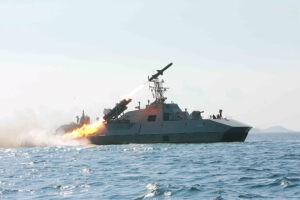
These forces are transported behind enemy lines to South Korea by around 100 NAMPO-class fast landing craft (26 metres, 76 tonnes) and around 130 KONGBANG-class hovercraft (approx. 20 metres). According to the US Army, the KONGBANG class, which was introduced in 1987, can deploy a good 50 armed soldiers over a distance of around 170 miles. The landing craft are organised in four squadrons, which are stationed in equal numbers on both coasts.
Submarines form the third operational pillar of the fleet. According to estimates, KPN maintains around 70 to 80 conventionally armed submarines, including 20 units of the ROMEO class and 40 units of the domestically developed SANG-O class. In addition, there are around ten small submarines each of the YUGO and the later YONO classes from the 1960s and 1990s. In purely mathematical terms, Pyongyang's submarine fleet is therefore the third largest in the world. However, most of the units are considered outdated, slow and comparatively loud. Nevertheless, the sheer number of available units is likely to be a strain on the ASW forces of South Korea, Japan and the USA.
The 77 metre long units of the ROMEO class are the only deep-sea capable fighter submarines. Some were imported from China from 1973, others were built under licence in North Korea. Due to their outdated sensors and low noise insulation, they are considered easy prey for Western attack submarines and ASW forces.
Launched in 1991, the 36-metre-long SANG-O boats are optimised for use near the coast. The units, which are armed with torpedoes and mines, are primarily used to protect their own waters and harbours. However, some of them are intended to transport combat swimmers. A variant known as the SANG-O-II, which is around 40 metres long and has an improved payload capacity and range, is to be introduced in 2011. In the event of war, together with the ROMEO class, they could take up positions off the South Korean harbours and at the northern end of the Tsushima Strait in order to attack incoming and outgoing warships or lay mines.
The 20-30 metre long YUGO and YONO classes have a displacement of 110 to 130 tonnes. Due to their size, they are difficult to detect in coastal waters, which means that - with their armament consisting of two torpedoes or sea mines - they also pose a threat to larger warships. In 2010, a YONO-class boat is said to have sunk a South Korean corvette. The submarines are also used for the covert transport of special forces to South Korea.
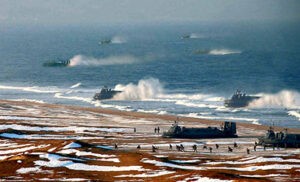
Submarines armed with ballistic missiles pose a new threat. According to current Western knowledge, only two of these boats are currently in active service. On 24 August 2016, the first launch of a Submarine Launched Ballistic Missile (SLBM) was carried out by the only unit of the GORAE or SINPO-B class to date. This boat was first identified on publicly available satellite images in 2014. The payload is carried in the turret, although it is still disputed whether there are silos for one or two missiles. The estimated size of the SINPO-B class is around 68 metres with a displacement of 1600 to 2000 tonnes and a range of around 1500 nautical miles. The submarine is optimised for operations in coastal waters and can remain on the seabed even with minimal use of the onboard systems. The operational endurance is estimated at a maximum of one month.
On 22 July 2019, North Korean President Kim Jong-un publicly inspected a new shipbuilding project at the Sinpo shipyard. According to North Korean sources, it was a new SLBM-capable submarine class. A satellite had already spotted two units under construction at the Sinpo shipyard in 2017. American sources as well as Japanese and South Korean media estimate the displacement at around 3,000 tonnes. According to Western analyses, this new class, known abroad as SINPO-C, is a conversion of ROMEO-class units and is therefore also referred to internationally as ROMEO mod (modified). Some analysts are of the opinion that the boats have an air-independent propulsion system. The most noticeable external change compared to the original ROMEO class is the turret, which is around twice as long and allows three or four SLBMs to be carried. It remains unclear whether North Korea intends to convert further boats of the original ROMEO class into SLBM-capable units in the long term.
Aiming for expanded development of power
A KN-11 (Pukgeukseong-1) missile was presumably used in the test firing in August 2016. Since then, several SLBM variants have been presented and partially tested, including the Pukgeukseong-6 variant, all of which are two-stage solid-fuel missiles that can be equipped with either a conventional or a nuclear warhead. Estimates of the potential range range from 500 to 2500 kilometres.
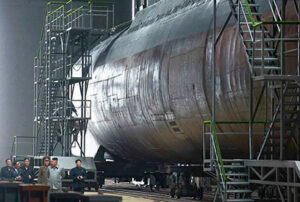
In January 2021, Kim Jong-un announced during the 8th Congress of the North Korean Workers' Party that his country had also developed plans to build a nuclear-powered submarine. Exact details of the design were not made public, but at the same time Kim stated that Pyongyang also wanted to develop a new submarine-launched ballistic missile with an intercontinental range. The submarine and SLBM are intended to "increase [the country's] ability to carry out long-range nuclear attacks", Kim explained. North Korea is therefore clearly pursuing a strategy of forcing the USA to remain neutral in the event of a future Korean War by threatening to launch a nuclear attack on an American city.
Although the actual construction of a nuclear-powered strategic submarine and corresponding missile will take years, North Korea's armaments development to date proves that the country is certainly capable of overcoming immense challenges autonomously.
The current introduction of submarines equipped with SLBMs with a regional deployment range is already changing the strategic situation in North-East Asia. Of particular importance here is the ability to attack targets in Japan, South Korea or on Guam from unpredictable directions, thereby exploiting weak points in the current missile defence structure. SLBMs armed with nuclear warheads would also provide Pyongyang with a second strike capability should its land-based nuclear weapons be neutralised in the event of a conflict. The fact that the individual North Korean weapons systems are inferior to the corresponding technology of South Korea, Japan and the USA should not obscure the fact that the North Korean operational doctrine based on mass, speed and contempt for death characterises an opponent that is definitely to be taken seriously.
Sidney E. Dean

